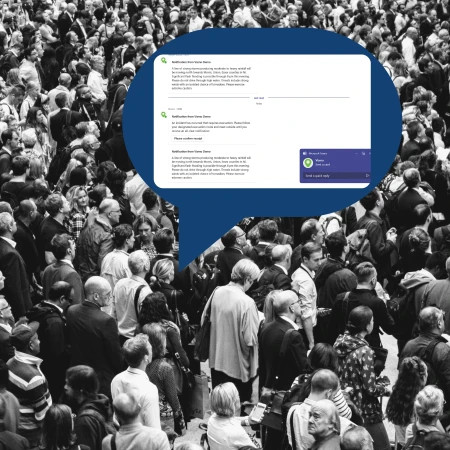Read Colin Dale, Director of Global Sales, latest article for International Security journal. Where he explains how a crisis management framework can help enhance worker safety -
In an increasingly unpredictable world, crisis management is no longer just an organisational requirement, it is imperative for employer organisations. Companies, public sector bodies and NGOs face a myriad potential disruptions, ranging from natural disasters, political instability and acts of terrorism to cybersecurity threats and unforeseen workplace incidents.
For employers, involved in high-stake operations in, or even outside, known geographical areas of risk, having a robust crisis management framework - and strategy - should be a given. It will enable in-house or contracted-out security teams to optimise responses to crises, including training staff to be aware that a crisis can happen at any time, and how to respond to one that occurs before a security team is aware of it.
A starting point is establishing a framework that starts with risk assessment, moves on to recommendations and planning, and finally execution of the planning.
The framework will enhance employers’ ability to mitigate risks and help ensure the safety of their staff - contract, freelance and volunteers included, no matter where they are in the world. The importance of risk assessment is that it shows where risks lie internally. That, in turn, provides a foundation for a culture change departmentally or organisation-wide if necessary – or simply, training, again if necessary - by highlighting weaknesses that need to be addressed.
Employers will then be well placed to embed risk reduction short to long term, via any necessary performance measurement - and “always on” technology-based methods of safety. The methods should allow for human interventions including recognising the severity of risks encountered or about to be encountered; and sending “mass notification” warnings and advice to all staff, a group of staff or to specific individuals, regardless of where they are travelling and working.
Understanding the crisis landscape
To summarise, crisis management encompasses the preparation, response and recovery from events that range from the disruptive to the threat to wellbeing including to life. Natural disasters, such as hurricanes and wildfires, continue to increase in frequency and intensity due to current global warming. Human error, political instability, civil unrest and acts of terror disrupt supply chains and jeopardise the safety of personnel.
Organisations should ask themselves critical questions:
-
Do we know where our employees are during a crisis?
-
How quickly can we communicate with them, assess their safety, give advice on how to optimise their safety, and provide physical support (e.g. ambulance, police, specialist security personnel and evacuation of necessary)?
-
Do we have the tools to respond effectively and ensure operational/business continuity?
For those seeking definitive answers, “always on” solutions exist, and include….
A panic button - to be activated on the phone/tablet/satellite device by a user when they suddenly find themselves in situation that is a direct threat to them. Pressing the panic button will alert security staff and, if necessary, the police, and trigger a cascade of help.
Real-time location tracking - One of the most critical aspects of crisis management is knowing the real-time location of employees. Advanced tracking technology will enable organisations to pinpoint the exact whereabouts of their staff, whether they are working in bustling metropolitan areas, remote locations or high-risk zones.
An app-based solution should be compatible with smartphones, tablets and satellite devices. The latter allows organisations to easily monitor their workforce where there is very weak or no network signal
Rapid mass - or individual – notification - During emergencies, delays in disseminating critical information can lead to confusion, missed opportunities, and, worst of all, potential harm to employees. A mass notification system that allows organisations to send instant alerts via multiple communication channels, including Slack, SMS, email, and in-app notifications is essential.
Staff should be able to report a crisis they foresee happening or has just happened in their immediate or close vicinity. By reporting it, they are adding to databases and intelligence about events and threats. Apps can boost crisis management through the use of high specification intelligence feeds that give data and information, including alerts, on possible, emerging and actual threats in real time anywhere in the world, or specific to an organisation’s geographic interest.
Geofencing - a geofence alerting system takes communication a step further by enabling organisations to target specific groups of employees, or just one individual, based on their location – including if they are about to enter a geofenced area - ensuring that only those affected by a particular crisis receive alerts and other help if required. Another benefit for an in-house or outsourced security team is that geofencing reduces data and information overload by using highly targeted – rather than wide angle, scattergun - location monitoring.
Other points to consider are…
Integrating an app – and its “back office” - with existing systems is key, because organisations often rely on multiple systems to manage their operations. The app and back office should ideally integrate seamlessly with other crisis tools and platforms including those use by the police and private security services. Interoperability ensures that organisations can leverage the benefits of their own infrastructure and the app’s state-of-the-art capabilities.
Another feature of an app and its back office should be the retention of historical location data. This feature is designed to help prevent violence against users, notably women and children because they are generally the most at-risk, in terms of violence and abuse, in society. Historical location data can be invaluable for authorities during investigations. It also enhances accountability and can be a deterrent to potential offenders.
Meeting the needs of international security professionals
Readers of International Security Journal are well-acquainted with the challenges of safeguarding personnel and assets across borders. The framework detailed above aligns with…
-
Global Reach. Whether managing crises in Europe, Africa, Asia, or the Americas, the technology works seamlessly across geographic boundaries.
-
Reliability. The technology functions even in challenging environments, ensuring uninterrupted service during critical events.
-
Data Security. The highest standards of data protection, ensuring that sensitive information remains secure.
-
ISO 31030 accreditation. ISO 31030 is the most recent standard in travel risk management. Before it was introduced there were no universal guidelines for travel risk management, forcing organisations to rely on their best judgement when implementing travel safety policy and procedure. The result was the inevitable, in many cases, gaps in efforts around people risk management.
-
Operational continuity. Operational continuity is an issue of critical importance to any organisation. Although staff are typically, or arguably, an organisation’s most valuable asset, one thing that should not be lost sight of is operational and related business continuity, a major component of crisis management.
A professional crisis management framework will reinforce not only an organisation’s response to a crisis but also operational and business continuity. It will, additionally, reinforcing staff’s confidence in their employer’s ability to protect them.
Read the full article in issue 73 of International Security Journal.
About the Author - Colin Dale has 13 years’ experience in crisis management and solutions nationally and internationally, and is Director of Global Sales, Vismo.
Want to Learn More - Request a product demo or explore our latest use cases and licence options to understand how Vismo can help you.






